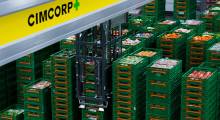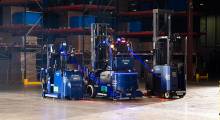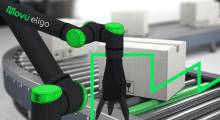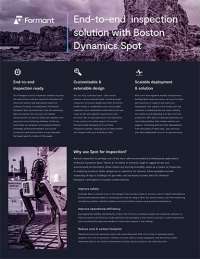Rewind the tape of the global economy by a few decades, and you'd seldom hear the term “supply chain,” which has been all over the news lately. Labor shortages, limited shipping and trucking capacity, and growing e-commerce demand have put logistics at the forefront of business profitability discussions. Robotics is part of the solution for global supply chains.
Universities and research institutions have been working on making robots more capable and easier to use. Meanwhile, progress is continuing, slowly but surely, in autonomous trucks and robotic deliveries. From factories, warehouses, and truck yards to loading docks and last-mile logistics, automation efficiency is welcome at each link in the supply chain.
Inflation, the aforementioned supply chain challenges, and a return to brick-and-mortar retail may slow investment in robotics. However, attendance at this year's trade shows and the move from pilots to full-fledged deployments suggest that more robots than ever will be in use during his year's holiday shopping season.
MIT develops smarter robots to find things
Walk into a physical store, and the product you want may not be on the shelf. You can ask a sales associate to “check in the back.” Similarly, a busy commuter might be ready to walk out the door but must first sift through clutter to find car keys.
Researchers at MIT have created a robotic system that uses RFusion. It consists of a robot arm with a camera and radio frequency (RF) antenna attached to its gripper. By fusing or combining signals from location signals and visual camera images, it's almost able to find the proverbial needle in a haystack.
For a supply chain model, many products have RFID tags attached that can communicate with a robot. MIT's RFusion prototype can detect RFID signals just about anywhere—even if buried under a pile of rubble.
RFusion uses machine learning to enable the robotic arm to zoom to the object’s exact location. It then verifies that the item is correct. RFusion integrates data from a camera, an antenna, and an arm programmed with artificial intelligence.
MIT's system is versatile and rugged enough to work in many different environments. It could help stores “check in the back” or locate missing shipments.
Automation anxiety affects labor unions
Supply chain managers must prepare for resistance from labor unions and those who fear losing their jobs to a new wave of technology. Businesses must explain to anxious workers and consumers that robots can actually create jobs.
Last year, the International Longshoremen’s Association (ILA) warned that its members would not work with automated machinery at marine terminals, will not work with automated machinery at seaports. Harold Daggett, president of the ILA, told the Journal of Commerce that automation projects around the world threaten job security in the maritime workforce.
“Workers around the world are under assault from the threat of automation by greedy companies only interested in making money and eliminating workers who helped them build their success and companies,” Daggett said. “It’s got to stop, and my ILA will do what it needs to do to save our jobs and the jobs of maritime workers around the world.”
Such opposition marks the beginning of a new chapter in labor relations, in which automation can be viewed as either a job killer or a tool for workforce recruitment, retraining, and retention.
The 'great resignation' and micro-fulfillment
Not only is there a shortage of drivers in the trucking industry, but there's also a shortage of logistics workers. Again, automation can perform certain tasks to augment existing staffs, noted Nada Sanders, a distinguished professor of supply chain management at Northeastern University.
In a Northeastern news article, she cited three examples. Micro-fulfillment centers, a step toward fully automated “dark stores,” can provide orders for nearby customers.
Amazon Go stores use cameras and intelligent software to track purchases and charge customers as they leave the premises, replacing cashier kiosks. Boston Dynamics' Spot quadruped can perform dangerous surveying tasks at construction sites.
As Sanders said, robots can perform the tasks that people don't want to do, supporting fulfillment in spite of workforce shifts.
Logistics picks up on robotics
Warehouse operators and third-party logistics providers (3PLs) are making healthy investments in automation for materials handling. For instance, shipping giant Maersk last year acquired Visible Supply Chain Management (SCM) for $838 million.
The deal followed Maersk's strategic goal of serving 75% of the U.S. direct-to-consumer market within 24 hours and to deliver to 95% of the U.S. market within 48 hours. The company gained nine fulfillment centers, accounting for more than 20 million sq. ft., to its distribution network.
In addition, Maersk said it expects Visible SCM to have synergy with its 2020 acquisition of Performance Team for $545 million. Performance Team focused on providing larger customers with robotics for distribution centers.
Japan a model for last-mile logistics
With robots and sophisticated routing, goods can avoid bottlenecks in distribution centers and loading docks when demand surges. Last-mile logistics automation could also mitigate urban congestion and help stores get products on shelves faster.
In Japan, delivery robots help to reduce costs and environmental impact while increasing collaboration, according to a McKinsey & Co. report.
“The surge in e-commerce volumes has put huge pressure on the last-mile delivery system, the process by which products are transported from distribution centers to final consumers,” the research firm said. “E-commerce sales worldwide grew sixfold in a decade, from $572 billion in 2010 to some $3.5 trillion at the end of 2019.”
McKinsey focused on Japan because it is “at the forefront of having to grapple with societal challenges such as labor shortages resulting from population decline and a hyper-aging society—something many developed countries will face in the future—exacerbating pressure on last-mile deliveries.”
Delivery robots that can transport packages weighing about 220 lb. or less at a maximum speed of 3 mph would be ideal, found the study. In fact, McKinsey said such robots can reduce carbon emissions and costs while responding to labor shortages.
Drones offer remote deliveries
In addition to long-haul autonomous trucks and last-mile robots, drones are becoming useful for more than consumer photography. A full-fledged delivery network hasn't been realized yet, but they can provide medicines in remote or underdeveloped areas.
Zipline has used drones for remote deliveries of lightweight medical supplies in Rwanda and Ghana, noted the Brookings Institute. The company worked with Pfizer and Ghana's drone infrastructure to demonstrate how technology firms and policy makers can collaborate to improve the health of a region or nation.
Supply chains enter a new age
Robots, drones, and autonomous vehicles are rapidly addressing the complexities of the modern supply chain. Fortunately, technology advances have coincided with a labor drought and global supply chain strains.
The global market for logistics automation could expand from $48.4 billion in 2020 to $88.9 billion by 2026, at a compound annual growth rate (CAGR) of 10.6%, according to Markets and Markets. It attributed that growth to e-commerce demand, advances in robotics, and the need to ensure worker safety.
Similarly, Research and Markets predicted a CAGR of 12.87%, with growth from $58.65 billion in 2021 to $121.27 billion by 2027, experiencing a compound annual growth rate of 12.87%. Market acceptance is even more important than the technology.
But we're seeing only the tip of the iceberg. More technology, including AI and robotics as a service (RaaS), is yet to come to provide agility and resilience to supply chain and logistics operations.
About the Author
Follow Robotics 24/7 on Linkedin
Article topics
Email Sign Up


















